管理学原理英文版课件Chapter 2The Management Environment
管理学英语ppt课件ppt课件
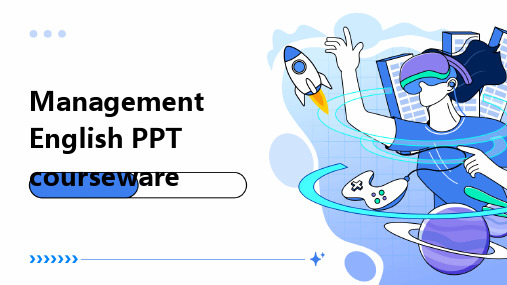
Risk control
Analyze potential risks, develop response measures, and ensure organizational safety.
Feedback and improvement
Collect feedback information, continuously improve management methods and processes.
Managerial Skills
Strategic vision
With a broad vision and the ability to plan for the long term.
Decision making ability
Scientifically analyze problems and make decisive decisions.
Communication and coordination skills
Good at communication and able to coordinate the interests of all parties.
Leadership
Unleash team potential and lead the team to grow together.
Establish an effective information communication mechanism to ensure the accuracy and timeliness of information transmission.
Leading
Motivation and Communication
管理学(英文版全套课件)
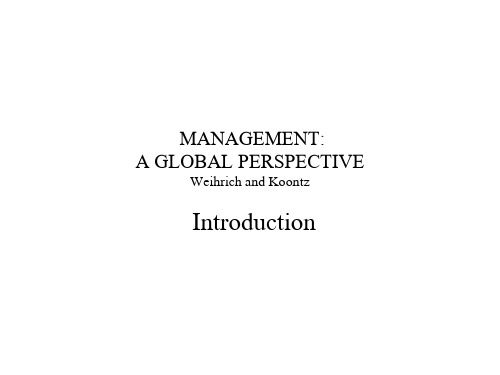
Arguments Against Social Involvement
• • • • • • • Violation of profit maximization Dilution of purpose Costs Too much power Lack of skills Lack of accountability Lack of universal support
• France
– Le Plan and the Cadre
• Germany
– Authority and Codetermination
• Korea
– Chaebol and Inhwa
Japanese Management
• Lifetime Employment • Seniority System • Decision Making in Japan
Chapter 2. Management and Society: The External Environment, Social Responsibility, and Ethics
The Organization and Its External Environment
Arguments for Social Involvement
Definition of Whistle-Blowing
管理学原理英文版——计划planning

Of production and service
5 STEPS TO RATIONAL DECISION-MAKING
• 1. Defining the problem • 2. Establish and weight criteria • 3. Generate alternatives • 4. Evaluate alternatives • 5. Determine the best solution
TOP TO BOTTOM PLANNING
• 1. Top management develops strategic plans
Starts with firm’s
• Vision • Mission
TOP TO BOTTOM PLANNING, cont’d
• 2. Middle management
LIMITATIONS OF RATIONAL DECISION-MAKING
• 1. Bounded rationality • 2. Maximizing vs Satisficing
TECHNIQUES OF GROUP DECISION-MAKING
• 1. Nominal
• 2. Delphi
SOME DISADVANTAGES
• Some possible negatives of planning are
1. May produce a false sense of certainty 2. May inhibit change & adaptiveness 3. May be too abstract and detached from daily activity
管理学原理讲义汇总
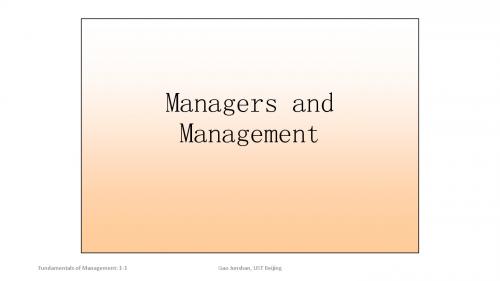
Liaison
Fundamentals of Management: 1-17
Gao Junshan, UST Beijing
Nature of management: Role model
Informational Roles
Monitor
Disseminator
Interpersonal Roles
Determining Where decisions are to be made
Fundamentals of Management: 1-13 Gao Junshan, UST Beijing
Nature of management: Functional view
Leading
Motivating employees
Entrepreneur
Nature of management: Universality
Contemporary Management Issues
Decision Making National Borders Handling Change
Fundamentals of Management: 1-23
• Relevant disciplines to management • Evolution of modern management practices • Contemporary approaches on Management
Fundamentals of Management: 1-3 Gao Junshan, UST Beijing
First-Level Managers Middle Managers Top Managers
24%
管理学原理英文版课件Chapter 2 The Management Environment

E-Organizations
• E-commerce (sales side of electronic business): any computer transaction that occurs when data are processed and transmitted over the internet
Entrepreneurship – the process of starting a business venture, organizing the necessary resources, and assuming the risks and rewards
Important Themes:
Public Expectations
Arguments for and against social responsibility by businesses must be
considered by manaibility = a firm’s obligation, beyond what is required by the law and economics, to pursue long-term goals that benefit society
advantages ◦ Starting the venture ◦ Managing the venture
Managing the Workforce
Downsizing – create more efficient operations through extensive layoffs
2管理学(双语)课件
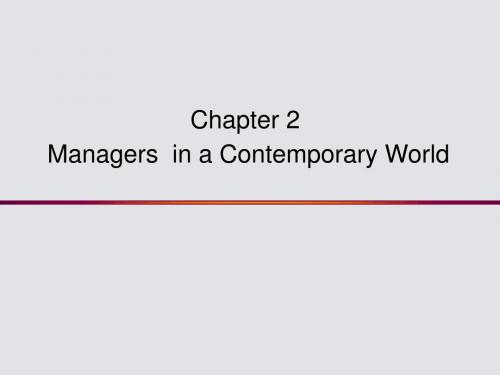
Learning Outcomes (cont’d) ’
6. Summarize the essential roles performed by managers. 7. Discuss whether the manager’s job is generic. 8. Describe the four general skills necessary for becoming a successful manager. 9. Describe the value of studying management. 10. Identify the relevance of popular humanities and social science courses to management practices.
– A management structure in which internal arrangements that impose artificial geographic barriers are broken down
Global Competition
• Multinational corporations (MNCs)
A Global Marketplace
• Global village
– The concept of a boundaryless world; the production and marketing of goods and services worldwide.
• Borderless organization
• Strategic alliances
– A domestic firm and a foreign firm share the cost of developing products or building production facilities in a foreign country.
管理学(斯蒂芬 罗宾斯 第九版)英文课件(第二章)

– Industrial Revolution • substitution of machine power for human power • large organizations required formal management
– Describe the contributions of the general administrative theorists一般行政管理
– Summarize the quantitative approach定量方法 to management
– Describe the contributions of the early organizational behavior组织行为 advocates
© Prentice Hall, 2002
2-13
EARLY ADVOCATES OF OB
© Prentice Hall, 2002ehavior (cont.)
Hawthorne Studies
– started in 1924 at Western Electric Company
– use of scientific methods to define the “one best way” for a job to be done
– perspective of improving the productivity and efficiency of manual workers
chapter 01 Managers and Managing 《管理学》(双语)课程课件
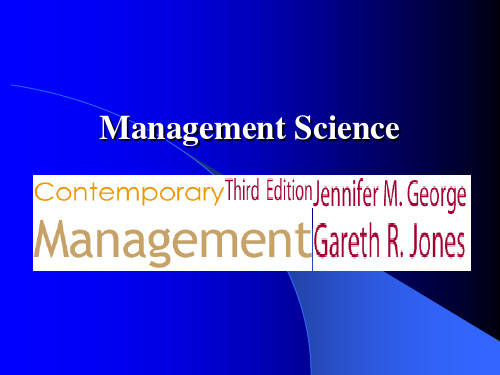
performance accurately and regulate efficiency and effectiveness.
anizing
Structuring working relationships in a way that allows organizational members to work together to achieve organizational goals.
Organizational Structure
Three steps in the planning process – Deciding which goals to pursue – Deciding what courses of action to adopt – Deciding how to allocate resources
14
16
4. Controlling
Evaluating how well an organization is achieving its goals and taking action to maintain or improve performance.
– Monitoring individuals, departments, and the organization to determine if desired performance standards have been reached.
Challenges for Management in a Global Environment
管理学原理第二章

•
Current
•
Issues and Trends
Explain why we need to look at the current trends and issues facing managers. Describe the current trends and issues facing managers.
Advocated the division of labor (job specialization) to increase the productivity of workers a hospital surgery team; restaurant kitchens
Industrial Revolution Substituted machine power for human labor Created large organizations in need of management
Scientific Management
Fredrick Winslow Taylor Putting the right person on the job with the correct tools and equipment. Having a standardized method of doing the job. Providing an economic incentive to the worker. Frank and Lillian Gilbreth Focused on increasing worker productivity through the reduction of wasted motion Developed the micro chronometer to time worker motions and optimize work performance The meaning of Science management Production is highly labor-intensive, builders ‗ major cost are brick and worker
管理学原理英文版最新版教学课件第2章

How Do Employees Learn the Culture?
Organizational stories: narrative tales of significant events or people.
Corporate rituals: repetitive sequences of activities that express and reinforce important organizational values and goals.
Culture Is:
• Perceived • Descriptive • Shared
Exhibit 2-4 Dimensions of Culture
Learning Organizational Culture
Where Does Culture Come From? Usually reflects the vision or mission of founders. Founders project an image of what the organization should be and what its values are.
Source: Robbins, Stephen P., Coulter, Mary, Management, 13th Ed., © 2016, p. 86. Reprinted and electronically reproduced by permission of Pearson Education, Inc., New York, NY.
Exhibit 2-2 Environmental Uncertainty Matrix
Managing Stakeholder Relationships
管理学原理英语

管理学原理英语Management PrinciplesIntroduction to Management PrinciplesManagement principles are a set of fundamental concepts that guide managers in their decision-making processes and actions. These principles are essential for effective management and are applicable in various organizational settings.1. Planning and Goal SettingPlanning involves setting objectives and determining the best course of action to achieve them. Managers should develop a clear vision and define specific goals that align with the organization's overall objectives. They should then formulate strategies, develop plans, and allocate resources to achieve these goals successfully.2. Organizing and CoordinationOrganizing refers to structuring and arranging resources and activities to accomplish organizational goals effectively. Managers need to divide tasks, assign responsibilities, and create a hierarchy of authority. Coordination is crucial to ensure that different individuals and departments work together towards common goals.3. Leading and MotivatingLeadership involves inspiring and guiding individuals and teams to achieve organizational objectives. Effective managers mustpossess strong leadership skills, such as the ability to communicate effectively, provide support, motivate employees, and resolve conflicts. Motivation is essential to encourage employees to perform at their best and contribute to organizational success.4. Controlling and Evaluating PerformanceControlling involves monitoring and evaluating performance to ensure that plans are on track. Managers should establish control mechanisms, such as performance indicators, and regularly assess progress. This allows them to identify deviations and take corrective measures promptly.ConclusionThese management principles provide a framework for managers to make informed decisions and effectively lead organizations. By understanding and applying these principles, managers can enhance productivity, improve employee satisfaction, and achieve long-term success.。
管理学英文版PPT

• Describe Katz’s three essential managerial skills and how the importance of these skills changes depending on managerial level.
What Is Management?
• Define management. • Contrast efficiency and effectiveness. • Explain why efficiency and effectiveness are important to management.
L E A R N I N G O U T L I N E (cont’d)
Follow this Learning Outline as you read and study this chapter.
What Do Managers Do?
• Describe the four functions of management.
• Top Managers
Ø Are responsible for making organization-wide decisions and establishing plans and goals that affect the entire organization.
What Is Management?
L E A R N I N G O U T L I N E (cont’d)
行政管理第二章(国际management经典教程英文原版)

management and workers.
Four Principles of Scientific Management
1) Study the ways jobs are performed now and determine new ways to do them. Gather detailed time and motion information. Try different methods to see which is best.
Job Specialization and the Division of Labor
Adam Smith (18th century economist) Realized that job specialization resulted in much higher efficiency and productivity Breaking down the total job allowed for the division of labor in which workers became very skilled at their specific tasks.
3) Select workers whose skills match the rules.
4) Establish fair levels of performance and pay a premium for higher performance. Workers should benefit from higher output
Frederick W Taylor (1856 – 1917)
管理学原理英文版课件Chapter 2The Management Environment

Customers
Pleasing customers
– This has gotten more and more difficult because consumers now have more and more choices
Attitude and Profit
5 Dimensions of National Culture:
– Power distance – Individual versus collective – Quantity versus quality of life – Uncertainty avoidance – Long versus short-term orientation
Organization’s Revenue/Profit
Customer Attitude
Employee Attitude
Responsiveness Culture
Key Variables
Employees – outgoing/friendly Freedom to meet customers’ requirements Empowering employees Listening skills
advantages – Starting the venture – Managing the venture
Managing Labor
Downsizing Rightsizing Outsourcing
Types of Workers
Contigent workers
– Part time employees – Temporary employees – Contract workers
管理学英文版.ppt

2019-7-2
谢谢你的观赏
4
Assessment by yourself 自我评估
Describe your organization
Efficiency? Effectiveness? Successful?
2019-7-2
谢谢你的观赏
5
Discussion 讨论
Mintzberg’s roles 明茨伯格角色论
Interpersonal 人际关系
Figurehead
Leader
Liaison
形象首脑:
接待访问者,签署法律文件
领导者:
激励下属,调配和培训人员
联络者:
维护外部形象,提供信息
2019-7-2
谢谢你的观赏
6
Informational 信息沟通
Monitor 信息收集人
top managers
coordinator
work teem
work teem
work teem
coordinator
work teem
work teem
work teem
2019-7-2
谢谢你的观赏
33
The horizontal corporation
Organization structure depends on work processes not function departments
Vertical structure flattening, only a few senior managers in traditional function departments such as financial and human resource sections.
《管理学原理双语》课件

3 其他疑问
如果有任何其他问题或疑虑,请随时向我们提问。
《管理学原理双语》PPT 课件
通过《管理学原理双语》PPT课件,我们将深入探讨管理学的基本原理和核心 概念,帮助学生学习和理解管理知识,掌握有效的管理技能。
课程介绍
1 课程背景
了解为什么学习管理学对个人和组织都至关 重要。
2 课程目标
明确学习此课程的目的和预期收获。
3 课程内容
概述课程中将涵盖的主要主题和学习内容。
课件资料
提供课程相关的幻灯片和资源 文件。
学习辅导
为学生提供辅导和支持的途径。
学习评估
1
作业和考试
评估学生对课程内容的理解和应用能力。
课堂参与
2
考核学生在课堂上的积极参与和贡献。
3
课程总结
总结课程学习成果和个人反思。
常见问题
1 如何购买教材?
提供购买教材的指导和建议。
2 如何联系老师?
提供与老师沟通和交流的方式。
4 教学方法
介绍采用的教学方法和互动学习工具。
教学大纲
第一章:管理学概述
介绍管理学的发展历史和主要理论。
第三章:决策与计划
探讨管理决策和有效计划的重要性。
第二章:管理环境和职能
讨论管理的外部环境和不同层级的管理职能。
第四章:组织和领导
解析组织结构和领导力的关键要素。
教学资源
课程教材
推荐教材和参考书籍以帮助学 生更好地学习。
管理学英语ppt课件ppt课件ppt

03
02
01
Modern management theory emphasizes the importance of flexibility, innovation, and adaptability in the management of enterprises
It emphasizes the need to respond quickly and effectively to changes in the external environment
Purpose
To ensure the effective utilization of resources, improve organizational efficiency and effectiveness.
Steps
including setting goals, developing strategies, preparing budgets, and developing action plans.
Definition
Purpose
Methods
The main functions of management
04
要点三
Definition
The process of selecting an optimal course of action from several possible alternatives
要点一
要点二
Importance
Decision making is a critical skill for managers as it helps them navigate through challenges and opportunities, make informed choices, and achieve desired outcomes
- 1、下载文档前请自行甄别文档内容的完整性,平台不提供额外的编辑、内容补充、找答案等附加服务。
- 2、"仅部分预览"的文档,不可在线预览部分如存在完整性等问题,可反馈申请退款(可完整预览的文档不适用该条件!)。
- 3、如文档侵犯您的权益,请联系客服反馈,我们会尽快为您处理(人工客服工作时间:9:00-18:30)。
International Business
Multinational corporations Transnational corporations Borderless organizations
Challenges for Managers: Culture and Environment
5 Dimensions of National Culture:
– Power distance – Individual versus collective – Quantity versus quality of life – Uncertainty avoidance – Long versus short-term orientation
Core employees
Customers
Pleasing customers
– This has gotten more and more difficult because consumers now have more and more choices
Attitude and Profit
GLOBE Dimensions
Using Technology
Equipment/methods designed to make work more efficient
Serve customers, enhance production, provide better information to decision makers
Manager’s role
Managers can affect customer satisfaction through labor by:
– Selection – Training – Organizing – Empowerment – Leadership – Evaluation – Rewards
– They must trust their employees
Organization’s Revenue/Profit
Customer Attitude
Employee Attitude
Responsiveness Culture
Key Variables
Employees – outgoing/friendly Freedom to meet customers’ requirements Empowering employees Listening skills
E-Organizations
E-commerce E-business
Expectations
Social responsibility
– Social obligation – Social responsiveness – Ethics
Morality Values Personality Experiences
Entrepreneurship
Entrepreneurship:
– Pursuit of opportunities – Innovation – Growth
ห้องสมุดไป่ตู้
Entrepreneurship
Steps:
– Exploring the entrepreneurial context – Identifying opportunities and possible competitive
Quality and Improvement
Quality management Continuous improvement Work process engineering
Letting-Go/Coaching
Managers cant’ know every job, every system, or every policy
管理学原理英文版课件Chapter 2The Management Environment
Evolution of Modern Civilization
Agriculture : 1890s Industrialization : 1890s – 1960s Information Wave : 1970s - present
advantages – Starting the venture – Managing the venture
Managing Labor
Downsizing Rightsizing Outsourcing
Types of Workers
Contigent workers
– Part time employees – Temporary employees – Contract workers
